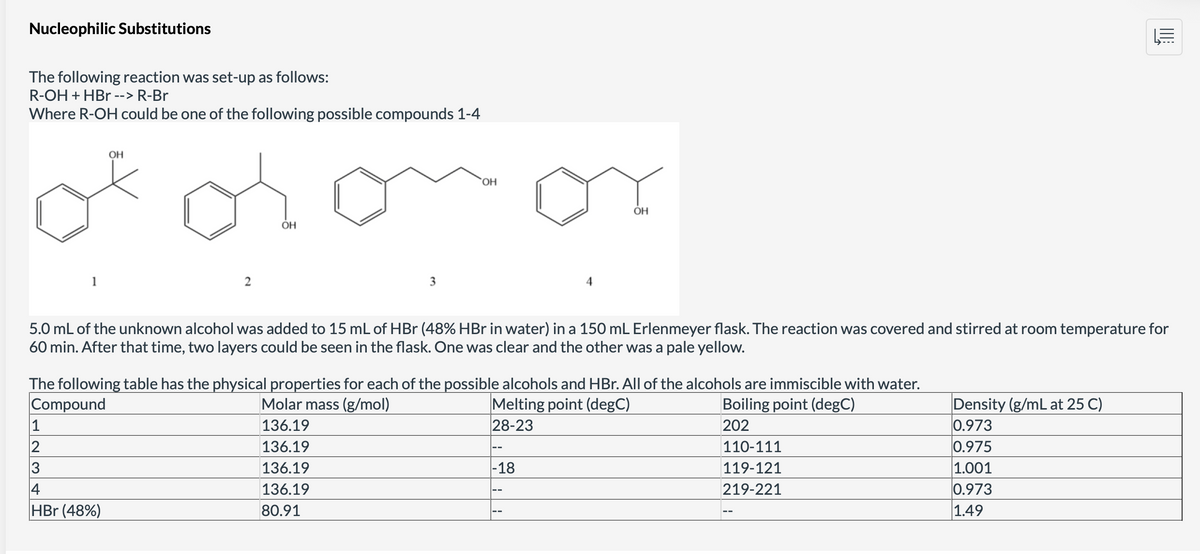9) What would be the difference between the 4 alcohols in IR? They all show O-H, C-H sp3, and C-H aromatic bonds. The only way to tell which one is used would be by comparing the fingerprint regions to published IR spectra of each alcohol. Alcohol 2 has an aldehyde C-H group that could be seen between 2700-2800 and 2800-2900 cm-1 Only alcohol 3 will show O-H bond around 3300 cm-1 Only alcohol 1 will show C=C aromatic bonds around 1600 cm-1 10) Assuming 5.0 mL of alcohol 2 was used and 2.2 g of the product was isolated, what is the percent yield for this reaction? The product has a molar mass of 198.00 g/mol. 11) How could the percent yield be increased for this reaction? Add NaOH to neutralize the product as it forms Add a catalyst such as H2SO4 to help speed up the reaction Add a catalyst such as HCl to help speed up the reaction Cool the reaction on ice to increase the rate of reaction
Analyzing Infrared Spectra
The electromagnetic radiation or frequency is classified into radio-waves, micro-waves, infrared, visible, ultraviolet, X-rays and gamma rays. The infrared spectra emission refers to the portion between the visible and the microwave areas of electromagnetic spectrum. This spectral area is usually divided into three parts, near infrared (14,290 – 4000 cm-1), mid infrared (4000 – 400 cm-1), and far infrared (700 – 200 cm-1), respectively. The number set is the number of the wave (cm-1).
IR Spectrum Of Cyclohexanone
It is the analysis of the structure of cyclohexaone using IR data interpretation.
IR Spectrum Of Anisole
Interpretation of anisole using IR spectrum obtained from IR analysis.
IR Spectroscopy
Infrared (IR) or vibrational spectroscopy is a method used for analyzing the particle's vibratory transformations. This is one of the very popular spectroscopic approaches employed by inorganic as well as organic laboratories because it is helpful in evaluating and distinguishing the frameworks of the molecules. The infra-red spectroscopy process or procedure is carried out using a tool called an infrared spectrometer to obtain an infrared spectral (or spectrophotometer).
9) What would be the difference between the 4 alcohols in IR?
They all show O-H, C-H sp3, and C-H
Alcohol 2 has an
Only alcohol 3 will show O-H bond around 3300 cm-1
Only alcohol 1 will show C=C aromatic bonds around 1600 cm-1
10) Assuming 5.0 mL of alcohol 2 was used and 2.2 g of the product was isolated, what is the percent yield for this reaction? The product has a molar mass of 198.00 g/mol.
11) How could the percent yield be increased for this reaction?
Add NaOH to neutralize the product as it forms
Add a catalyst such as H2SO4 to help speed up the reaction
Add a catalyst such as HCl to help speed up the reaction
Cool the reaction on ice to increase the
12) Is there another way that the product of this reaction could be isolated and purified?
Set up a co-distillation of immiscible liquids so that only the
Recrystallize the product from ethanol
Set up a co-distillation of immiscible liquids so that all impurities distill and leave just the product behind
Set up a co-distillation of immiscible liquids so that the alkyl halide is left with just water to remove
13) How would the product and the starting alcohol differ in IR?
The product should not have an O-H bond or the sp3 C-H bonds
The product should have sp3 C-H bonds and the alcohol will not
The product should not have an O-H bond, but will still have the sp3 and aromatic C-H bonds
Both have aromatic C-H bonds but only the product will have C=C aromatic bonds in the IR

Trending now
This is a popular solution!
Step by step
Solved in 4 steps with 2 images






